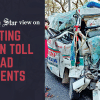A misguided approach to road safety

We are quite surprised by the comments made by the Road Transport and Highways Division secretary as well as transport leaders at a recent workshop. Terming the road crash data prepared by different independent platforms as "fabricated," they claimed that the numbers of road crashes and deaths had come down last year compared to previous years. They even came up with a somewhat twisted justification by comparing the number of crashes and deaths with the number of vehicles plying on our roads. According to a BRTA director, while the numbers of crashes and deaths were 2,827 and 2,646 for 14.24 lakh vehicles in 2010, the figures were 5,200 and 4,638 for 55.92 lakh vehicles in 2022. We wonder what this comparison even means, with ordinary people frequently losing their lives or limbs in the absence of proper measures to prevent it.
Road safety campaigners such as Bangladesh Jatri Kalyan Samity, Nirapad Sarak Chai, and Road Safety Foundation Bangladesh unveiled their annual reports on crashes and deaths earlier this month. In that, they invariably claimed that the numbers of crashes and deaths had actually increased last year. According to Jatri Kalyan Samity, 9,951 people were killed in 6,749 crashes, while the numbers of deaths and crashes, according to Road Safety Foundation, were 7,713 and 6,829 respectively. However, according to police data, the numbers of accidents and deaths last year were 5,200 and 4,638.
The question is, why is the police showing fewer accidents and deaths? The answer, we think, is simple. While road safety campaigners collect data from media reports, the police reportedly rely solely on first information reports or general dairies for such data. So, while police data should be more reliable in any country, that is not the case in Bangladesh. The World Bank, in one of its reports, observed that our current system of recording and analysing data is error-prone, cumbersome and time-consuming. They also found a huge discrepancy between the WHO data and the police data – while the WHO estimated around 24,954 road crash deaths in 2016, the police only reported 2463 deaths in the same year.
And even if there may be some gaps in the way different organisations record data, they highlight an increasing upward trend in road crashes and deaths, which the authorities cannot overlook. Moreover, can the authorities term independent organisations' data "fabricated" when the government itself lacks a proper mechanism in recording this kind of data?
The transport authorities and leaders must remember that road crashes are not a percentage game; it is a reality for us. One life lost is one too many. The government's efforts should be aimed at curbing this menace by properly recording related data and working on it, enforcing the road transport act, and overhauling the entire transport sector.


 For all latest news, follow The Daily Star's Google News channel.
For all latest news, follow The Daily Star's Google News channel. 






Comments